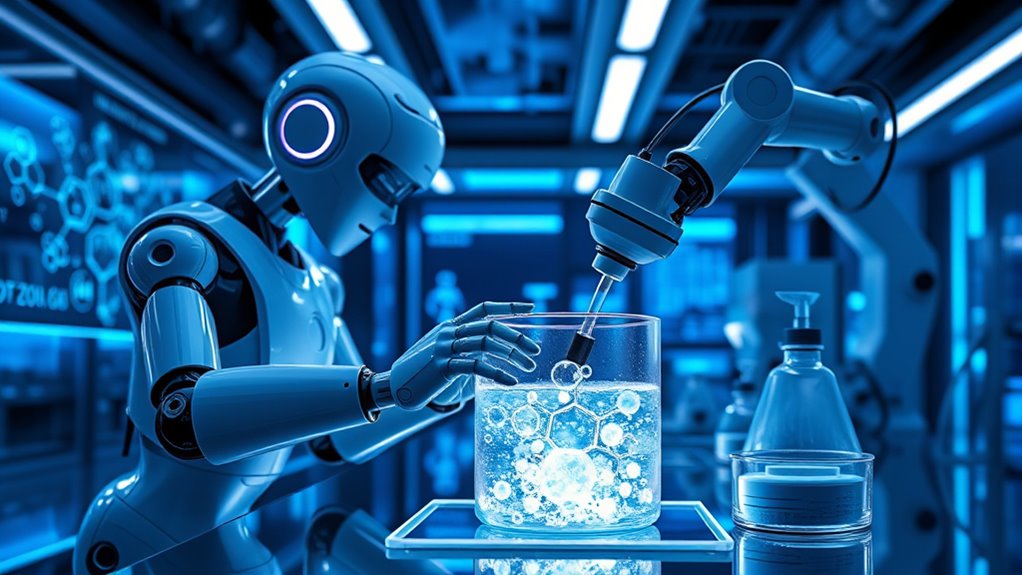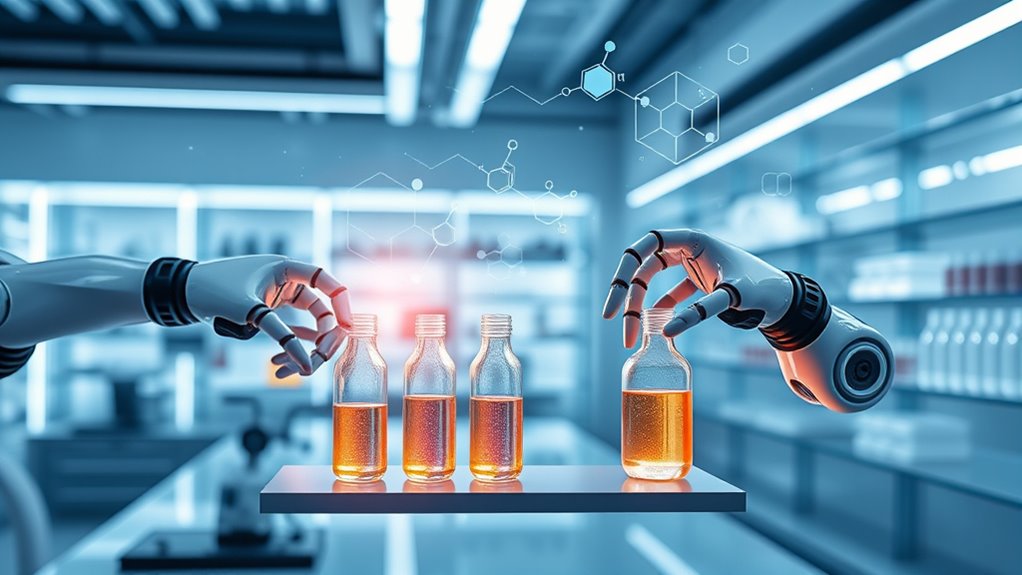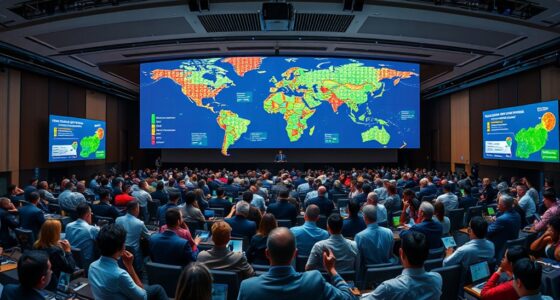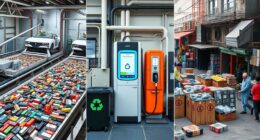The future of lifecycle management revolves around AI, robotics, and new chemistries that make asset oversight smarter, safer, and more sustainable. AI analyzes data to predict failures and optimize maintenance, while robotics handle hazardous tasks for better safety. Cutting-edge materials extend asset life and reduce environmental impact. Combining these innovations with digital twins and sustainable practices creates an integrated approach that adapts to evolving technologies and environmental goals. Discover how these trends will shape your asset management journey.
Key Takeaways
- AI and machine learning will enable predictive maintenance, reducing downtime and extending asset lifespan.
- Robotics will automate hazardous and repetitive tasks, improving safety and operational efficiency.
- New chemistries and materials will create more durable, eco-friendly assets that support sustainability goals.
- Digital twin technology will allow real-time performance simulation, optimizing lifecycle decisions from procurement to disposal.
- Integrated digital strategies will promote adaptive, intelligent lifecycle management for resilient, sustainable operations.

The future of lifecycle management is poised for transformation as emerging technologies and data-driven strategies reshape how organizations oversee their assets from inception to disposal. At the heart of this evolution lies a focus on sustainable innovation, which pushes you to find smarter, eco-friendly ways to design, maintain, and eventually retire assets. Digital transformation plays a vital role here, enabling you to harness real-time data, automate processes, and make smarter decisions that reduce waste and improve efficiency. As you integrate these tools, you’re not just managing assets more effectively — you’re actively contributing to a greener, more sustainable future.
Embrace digital transformation to drive sustainable innovation and create a greener future through smarter asset lifecycle management.
Artificial intelligence (AI) and machine learning are becoming central to lifecycle management. They help you analyze vast amounts of data to predict equipment failures, optimize maintenance schedules, and extend asset lifespan. This proactive approach minimizes downtime and lowers costs, making your operations more resilient. Robotics further enhance this process by automating repetitive or hazardous tasks, such as inspections or repairs. Using robots in maintenance routines allows you to operate more safely and efficiently, especially in environments that are dangerous or difficult to access. These advancements, combined with digital transformation, mean you can gather and interpret data faster, respond more swiftly to issues, and plan for long-term sustainability.
New chemistries are also shaping the future of lifecycle management by enabling more durable, eco-friendly materials. When you adopt innovative chemistries, you can develop assets that last longer, are easier to recycle, and have less environmental impact. These advancements support your goals of sustainable innovation, helping you meet regulatory requirements and societal expectations around environmental responsibility. By incorporating these new materials into your asset lifecycle, you not only improve performance but also contribute to reducing the ecological footprint of your operations.
As these technologies continue to evolve, the way you approach lifecycle management will become more integrated and intelligent. You’ll leverage digital twin models to simulate asset performance under various conditions, enabling you to test and optimize before implementing real-world changes. Data-driven insights will guide you in making more sustainable choices, from procurement to disposal, aligning operational efficiency with environmental stewardship. Ultimately, your ability to adapt to these innovations will determine your success in navigating the future landscape of asset management, where sustainability and digital transformation go hand in hand to create smarter, more responsible organizations.
Frequently Asked Questions
How Will AI Impact Workforce Skills in Lifecycle Management?
AI integration will profoundly impact your workforce skills in lifecycle management by automating routine tasks and providing advanced data analysis. You’ll need to adapt by developing technical skills related to AI tools and data interpretation. Your team will also require continuous learning to stay ahead of technological changes. Embracing these shifts ensures you remain efficient, competitive, and capable of leveraging AI’s full potential in managing product lifecycles effectively.
What Are the Environmental Implications of New Chemistries?
You should consider that new chemistries can markedly reduce environmental impact by lowering toxic emissions and improving biodegradability. However, you must also prioritize chemical safety, ensuring thorough testing and regulation to prevent unintended ecological harm. Responsible development of these chemistries can lead to more sustainable products, but neglecting safety protocols might cause pollution, harm ecosystems, and pose health risks. Stay vigilant to balance innovation with environmental responsibility.
How Secure Are Ai-Driven Lifecycle Management Systems?
Like a fortress guarding a treasure, your AI-driven lifecycle management system offers robust security, but it’s not invincible. You face ongoing risks from data privacy breaches and system vulnerabilities that cyber villains can exploit. You must implement strong encryption, regular updates, and vigilant monitoring to stay ahead, just as a knight defends their domain. Trust in layered security measures keeps your system resilient against evolving threats.
Can Robotics Fully Replace Human Oversight in Complex Processes?
Robotics can’t fully replace human oversight in complex processes because autonomous decision making still relies on human judgment, especially when ethical considerations come into play. You need human intuition to navigate unpredictable situations, interpret nuanced data, and uphold ethical standards. While robotics enhance efficiency, you must remain involved to guarantee decisions align with moral values and adapt to unforeseen challenges, preventing complete automation from overshadowing human oversight.
What Regulatory Challenges Exist for Emerging Chemistries?
You face regulatory challenges with emerging chemistries, including lengthy regulatory approval processes and steering complex safety assessments. Patent hurdles can also delay market entry and increase costs. Staying ahead requires understanding evolving regulations and engaging with authorities early. By proactively addressing these hurdles, you can streamline approval timelines and protect your innovations, ensuring your new chemistries reach the market efficiently and compliantly.
Conclusion
As you embrace AI, robotics, and new chemistries, you’re shaping a smarter, more sustainable lifecycle management future. These innovations will streamline processes, reduce waste, and extend product longevity. Remember, “A chain is only as strong as its weakest link”—so, by adopting cutting-edge tech now, you strengthen the entire system. Stay adaptable and forward-thinking, because in this rapidly evolving landscape, your proactive approach will determine your success.









